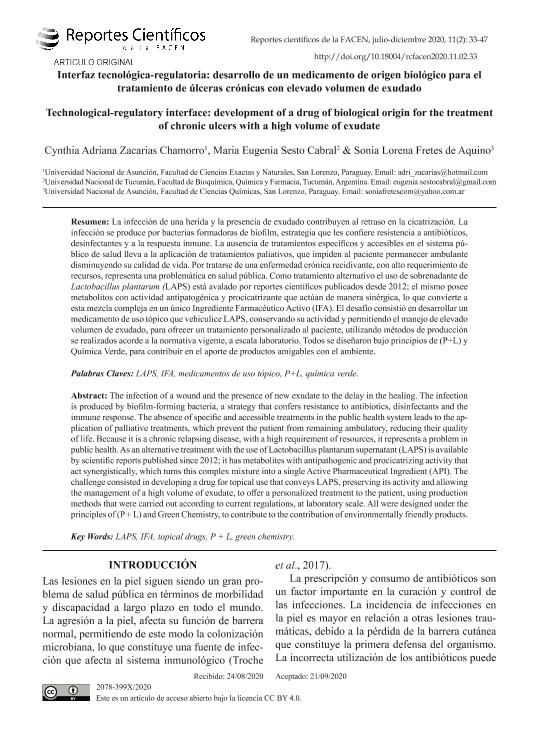Artículo
La infección de una herida y la presencia de exudado contribuyen al retraso en la cicatrización. La infección se produce por bacterias formadoras de biofilm, estrategia que les confiere resistencia a antibióticos, desinfectantes y a la respuesta inmune. La ausencia de tratamientos específicos y accesibles en el sistema público de salud lleva a la aplicación de tratamientos paliativos, que impiden al paciente permanecer ambulante disminuyendo su calidad de vida. Por tratarse de una enfermedad crónica recidivante, con alto requerimiento de recursos, representa una problemática en salud pública. Como tratamiento alternativo el uso de sobrenadante de Lactobacillus plantarum (LAPS) está avalado por reportes científicos publicados desde 2012; el mismo posee metabolitos con actividad antipatogénica y procicatrizante que actúan de manera sinérgica, lo que convierte a esta mezcla compleja en un único Ingrediente Farmacéutico Activo (IFA). El desafío consistió en desarrollar un medicamento de uso tópico que vehiculice LAPS, conservando su actividad y permitiendo el manejo de elevado volumen de exudado, para ofrecer un tratamiento personalizado al paciente, utilizando métodos de producción se realizados acorde a la normativa vigente, a escala laboratorio. Todos se diseñaron bajo principios de (P+L) y Química Verde, para contribuir en el aporte de productos amigables con el ambiente. The infection of a wound and the presence of new exudate to the delay in the healing. The infection is produced by biofilm-forming bacteria, a strategy that confers resistance to antibiotics, disinfectants and the immune response. The absence of specific and accessible treatments in the public health system leads to the application of palliative treatments, which prevent the patient from remaining ambulatory, reducing their quality of life. Because it is a chronic relapsing disease, with a high requirement of resources, it represents a problem in public health. As an alternative treatment with the use of Lactobacillus plantarum supernatant (LAPS) is available by scientific reports published since 2012; it has metabolites with antipathogenic and procicatrizing activity that act synergistically, which turns this complex mixture into a single Active Pharmaceutical Ingredient (API). The challenge consisted in developing a drug for topical use that conveys LAPS, preserving its activity and allowing the management of a high volume of exudate, to offer a personalized treatment to the patient, using production methods that were carried out according to current regulations, at laboratory scale. All were designed under the principles of (P + L) and Green Chemistry, to contribute to the contribution of environmentally friendly products.
Interfaz tecnológica-regulatoria: desarrollo de un medicamento de origen biológico para el tratamiento de úlceras crónicas con elevado volumen de exudado
Título:
Technological-regulatory interface: development of a drug of biological origin for the treatment of chronic ulcers with a high volume of exudate
Fecha de publicación:
12/2020
Editorial:
Universidad Nacional de Asunción. Facultad de Ciencias Exactas y Naturales
Revista:
Reportes Científicos de la FACEN
ISSN:
2222-145X
e-ISSN:
2078-399X
Idioma:
Español
Tipo de recurso:
Artículo publicado
Clasificación temática:
Resumen
Archivos asociados
Licencia
Identificadores
Colecciones
Articulos(INBIOFAL)
Articulos de INSTITUTO DE BIOTECNOLOGÍA FARMACEUTICA Y ALIMENTARIA
Articulos de INSTITUTO DE BIOTECNOLOGÍA FARMACEUTICA Y ALIMENTARIA
Citación
Zacarias Chamorro, Cynthia Adriana; Sesto Cabral, María Eugenia; Fretes de Aquino, Sonia Lorena; Interfaz tecnológica-regulatoria: desarrollo de un medicamento de origen biológico para el tratamiento de úlceras crónicas con elevado volumen de exudado; Universidad Nacional de Asunción. Facultad de Ciencias Exactas y Naturales; Reportes Científicos de la FACEN; 11; 2; 12-2020; 33-47
Compartir
Altmétricas




